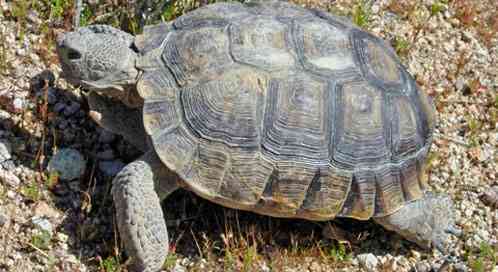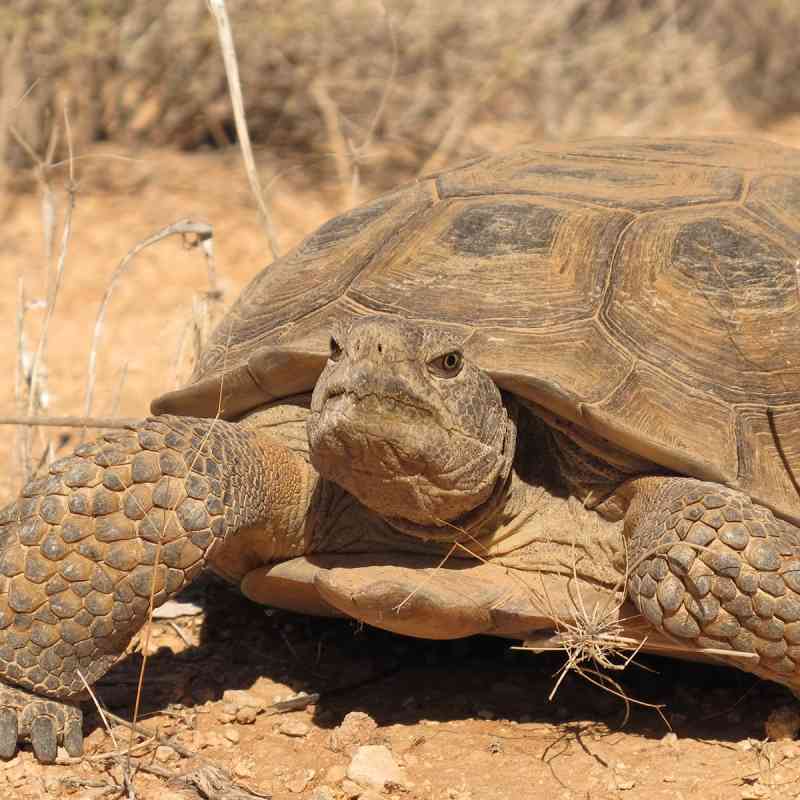“Smart-from-the-start” solar-energy plan ensures fewer risks to wildlife

Building solar-energy fields on already developed land can help protect desert tortoise habitat.
The desert landscape is looking even brighter now that the Interior Department has released its first roadmap for environmentally responsible solar-energy development on public lands in the West. According to the map, unfurled this fall, this means the Bureau of Land Management (BLM) will direct solar-energy projects to areas that avoid or have reduced impacts to wildlife and wild lands in Arizona, California, Colorado, Nevada, New Mexico and Utah.
“The decision to direct solar projects to low-conflict areas is a much more rational approach to renewable energy development on public lands,” says Jamie Rappaport Clark, Defenders’ president. “This is better for wildlife, energy developers, utilities and investors alike because it offers a more efficient way to get environmentally friendly renewable energy on line and greater certainty for all involved.”
But she adds that the impact of the plan on the federally threatened desert tortoise is still a concern because the plan allows for some vital tortoise habitat to remain open to potential development. “The BLM and U.S. Fish and Wildlife Service should have taken a more cautious approach to exclude these areas or delay solar development until more scientific information becomes available on the impact of these projects on the species,” says Clark. “Instead, they chose to merely ‘discourage’ development in these areas. This creates greater uncertainty for developers and could undermine the survival and long-term sustainability of a unique and iconic desert species.”
In total, 17 solar-energy zones were finalized over approximately 280,000 acres, which represents a significant reduction from earlier proposals.
Development can also occur on a case-by-case basis on an additional 19 million acres of BLM lands outside the solar development zones—although the plan technically discourages it.
Over the past two years, Defenders urged the Obama administration to adopt upfront, “smart-from-the-start” principles for planning, designing and managing renewable energy projects that avoid or minimize the impact to sensitive desert land and wildlife—like the desert tortoise, bighorn sheep, golden eagle and Mojave ground squirrel.
Since some solar projects can sprawl over 8,000 acres or more, if located in sensitive habitats their sheer size can result in significant habitat loss and fragmentation. This can make it difficult for wildlife to find food, water, shelter, mates and protection from predators. Fragmented habitat can also lead to smaller, isolated populations of wildlife, making long-term survival more difficult.
“In our efforts to switch to clean energy and reduce greenhouse gas pollution, we must ensure that development of utility-scale solar power does not preclude wildlife from migrating to lands essential for climate change adaptation,” says Erin Lieberman, Defenders’ western policy advisor for renewable energy and wildlife. “We need to encourage the development of solar, wind and geothermal energy for all the benefits they provide. But we must not do it at the expense of our nation’s rich wildlife legacy.”
Defenders will continue working with stakeholders and the Department of the Interior to ensure that large-scale solar development occurs in places of least conflict so that wildlife and natural resources, like the desert tortoise, are protected.
Only select articles from Defenders are available online. To receive 4 issues annually of the full award-winning magazine, become a member of Defenders of Wildlife!
Related


